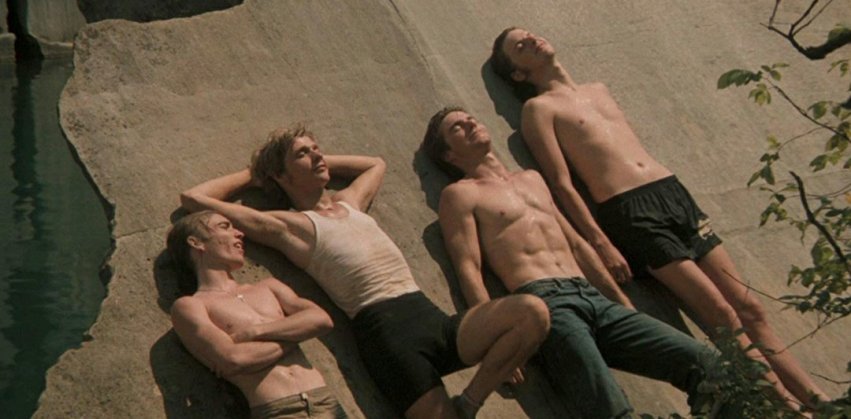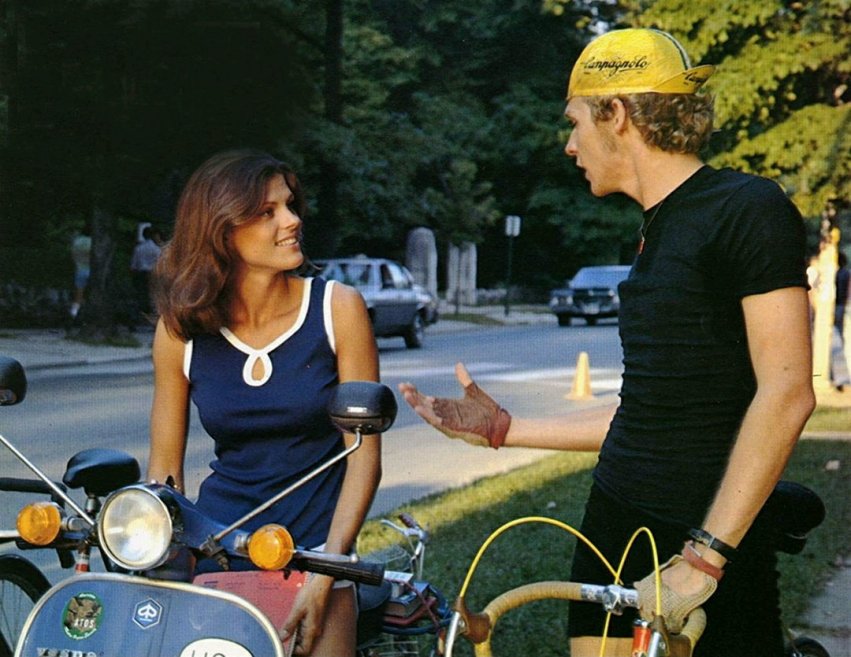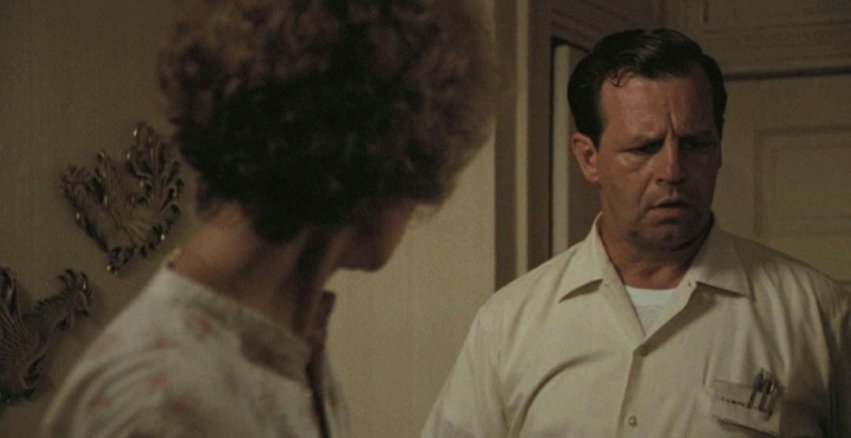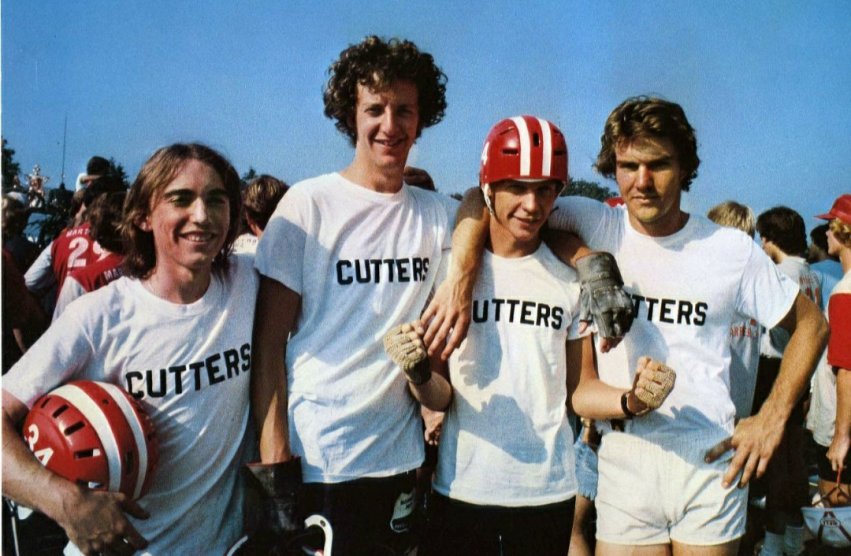
‘Coming of Age’ like any other genre in cinema, is pretty diverse. On the one hand, it is populated with cheesy high-school dramas, with stock characters which try to pass-off as relatable, while being illusory in their depiction of teenage and adolescence. And on the other hand, we are occasionally gifted with poignant character pieces, films which portray strong characters with an individualistic personality and in doing so, manage to make them relatable.
Breaking Away belongs to the second category. While minimalist in its plot, Breaking Away is populated with intriguing characters. And relies on enchanting character moments, to present us with a realistic portrait of adolescence, the frustrations of growing up and adulthood, set against the backdrop of class – conflict.

In the opening shot, we meet Dave (Dennis Christopher), Mike (Dennis Quaid), Cyril (Daniel Stern) and Moocher (Jackie Earle Haley), while they are hanging out at an abandoned water-filled quarry. Having graduated high-school about a year ago, and having spent the past year, pretty much idle, these 18-19 year old boys are trying to figure out what they want from their lives, and their place in the world. The opening shot is brilliant, in how it sets up the mood and tonality of the film, and also because like the majority of the film, its extremely dialogue driven.
“While minimalist in its plot, Breaking Away is populated with intriguing characters.”
Within the first few minutes we meet our central characters, understand their interpersonal dynamics, and we also get to see them at the quarry. The quarry is far more than just a scenic hangout spot, it’s a part of their identity. The boys often find themselves at odds with the more affluent kids around town, the students of Indiana University, who habitually call them ‘Cutters’. A derogatory term, used to refer to the families associated with the Indiana limestone industry, the stone cutters who worked at the quarry.
In a world riddled with class-conflict, the quarry serves a dual purpose. On the one hand, its a reminder of their roots, a reminiscent of their parent’s past as stone cutters. On the other, its a safe place, giving our characters a sense of belonging, when the rest of town feels aloof.

The most fascinating aspect of Breaking Away for me was how it uses its characters to present different approaches to oppression. On the one hand is Mike, constantly scorned at his position in the society, his yearning to escape is far more obvious than the rest of the characters. He longs for the fame he once had as a high-school football star, and pretends he doesn’t want to go to college. Denial is his brand of escapism, and he is quick to aggression, ready to fight the college kids at the drop of a hat.
“The most fascinating aspect of Breaking Away for me was how it uses its characters to present different approaches to oppression.”
On the other hand, there’s Moocher, a generally amicable character. Moocher’s short height often subjects him to ridicule. His brand of escapism, is one, where he focuses on body-building, and his romantic relationship. While Moocher is usually tranquil, if you call him Shorty, he is 100% going to fight back, his response to oppression is a bit more selective.
Then, there is Dave, the film’s central character to a certain extent. Dave’s longing to escape is far more subdued than Mike’s. Instead of wanting to fight the college kids or the upper class kids, he strives to define his own identity, one that is free from his societal status, only to recognise how difficult that can be.
Dave’s approach to oppression, can be seen as passable, because at one point he literally passes as an affluent college student. He manages to serenade a university student named Katherine (Robyn Douglass) by masquerading as an Italian foreign exchange student. His obsession with Italian culture and competitive bicycling, is his form of escapism, and it’s as charming a depiction of teenage fascinations, as it is honest.
Finally, there’s Cyril, the quietest of them all. He doesn’t speak much, rarely if ever raises his voice. In fact, even when he gets beaten up by some of the college boys, even then, his instinct is to avoid conflict, instead of wanting to fight back.
“The Academy Award winning screenplay by Steve Tesich is more interested in drawing a contrast between how societal structure impacts individuals, than it is in judging it’s own characters.”
What approach is preferable, the film doesn’t say. The Academy Award winning screenplay by Steve Tesich is more interested in drawing a contrast between how societal structure impacts individuals, than it is in judging it’s own characters, or their individual whimsies.

Dave’s parents (Ray and Evelyn Stohler), played brilliantly by Paul Dooley and Barbara Barrie, provide the film with much of its comic fodder. Ray’s anger towards his son’s obsession with Italian culture, music and cuisine, often seems to be misdirected. And while it gives the audience some truly funny moments, because his dialogue delivery, has a distinct “Old Man yells at a cloud” energy to it, ultimately its a reflection of his deep inner frustrations and adult cynicism. Evelyn Stohler gets minimum screen time, but is fascinating in how she balances her duties as a loving wife and an understanding mother. Despite how often her husband and her son are at odds with one another.
Mr. Stohler ( at one point, says about Dave): He’s never tired. He’s never miserable.
Mrs. Stohler: He’s young.
Mr. Stohler: When I was young, I was tired and miserable.

Bicycling takes up a huge chunk of the film and for good reason. Its a quite literal representation of Dave’s longing to ‘break away’ and it imparts this breezy coming of age film with the undertones of a competitive sports drama. My favourite shot from the film is when Dave follows a Cinzano truck at 60 mph to Bloomington Indiana, everything about that shot is nerve-wracking. That single scene is a perfect example of the technical mastery involved in the bicycling shots of the film. A combination of clever camerawork and ingenious background score.
“Bicycling takes up a huge chunk of the film and for good reason.”
Bicycling even constitutes the film’s final act. When Dave attempts to ask Katherine out on a date, while singing outside her dorm room, with Cyril as his companion, this doesn’t sit right with her boyfriend Rod. This escalates into brawl between the cutters and the college students, which ultimately ends up giving the cutters getting a chance to compete in the annual Indiana University race: Little 500, which is a relay bicycling race.
The race in itself follows predictable beats, despite being engaging to watch. What is more important, is what the race represents and what it means in the context of the film. It’s a chance for the cutters to be redefine their identities, and to prove themselves.

Overall, while the film suffers from a feeble middle act, and some of its side characters being underwritten, its a strong entry in the roster of 1979 films. It’s funny, charming, energetic, intelligent and the acting performances, especially from Dennis Christopher and Paul Dooley are stellar. Director Peter Yates does a great job of balancing the competitive and at times ominous tonality of these shots, with the relaxed pacing and summertime feel and fabric of the film.
In reality, class conflict runs far deeper than the teenage brawls and the provocative name-calling. So outside the world of cinema, the solution to the woes of our characters couldn’t be neatly wrapped up in a bow. So while the cutters or the Fab4 as I like to call them, might win the Little 500, and it may give them a sense of belonging and pride, it wouldn’t counter the years of marginalisation they or their parents have faced. But,within the context of the film, it’s resolution works. Breaking Away is meant to be an inspirational film and it works well as one.
I wish more people would see it.























